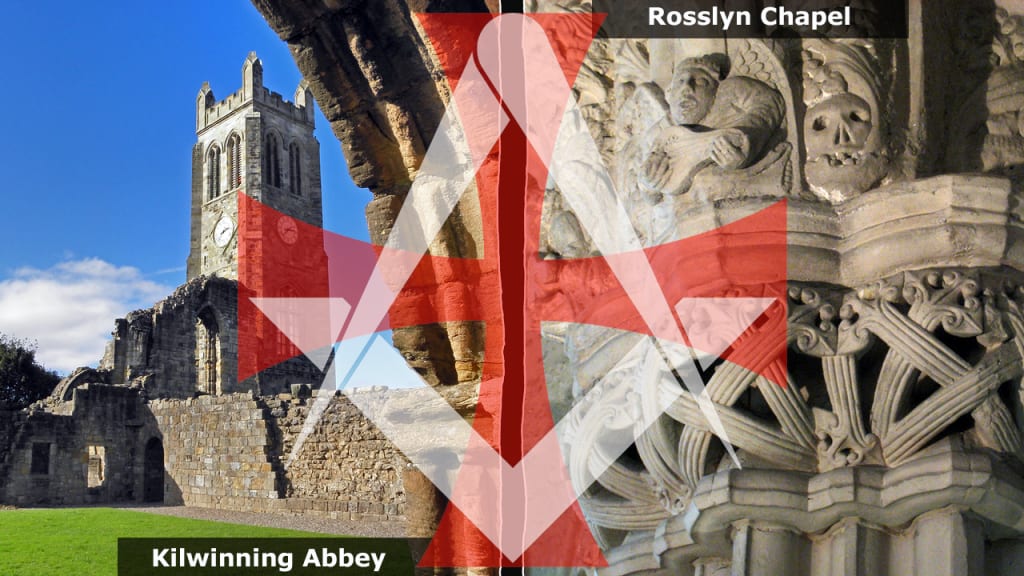From Templars to Masons on the secret journey to Scotland
Was Kilwinning where the knights turned to stone?

Rumours of deviant sexual rituals are not exclusive to the Knights Templar, who amassed a vast fortune between their foundation by Frenchman Hugues de Payens, along with a group of eight acquaintances, in about 1118 and their alleged dissolution in 1312, after King Philip IV of France – deeply in debt to the knights – pressured Pope Clement V to have many of the order's members in France arrested, tortured into giving false confessions and then burned at the stake as a result of his accusations.
Calling themselves the Poor Fellow-Soldiers Of Christ And The Temple Of Solomon, later known simply as the Knights Templar, they came into being after the Crusaders captured Jerusalem from Muslim hands in 1099 to protect groups of Christian pilgrims, from across western Europe, visiting the Holy Land from being robbed and killed as they passed through Muslim-controlled territories.
With the support of Baldwin II, the ruler of Jerusalem, they set up headquarters on Temple Mount, pledging to protect the Christian visitors to the city.
Initially they met with criticism from many religious leaders but after 1129 they received the formal endorsement of the church and support from Bernard of Clairvaux, a prominent French abbot instrumental in Pope Innocent II becoming head of the Catholic church in 1139… the new pontiff issuing a papal decree that allowed the knights special rights including exemption from taxes, permission to build their own oratories and accountability to no one but the Pope himself.
These papal “bulls” allowed the Templars to amass a vast fortune over the next 150 years that mysteriously disappeared after 1312, following King Phillip’s accusations that brought an end to the special privileges and saw the order persecuted in France.
Now it seems to me that it would be incredibly naive to believe that an organisation of such power, with followers across the continent, would simply call it a day and disappear into oblivion. To my eyes a far more likely scenario is that followers simply took off their uniforms and bought passage to a safer haven, taking what was left of their plunder from the Holy Land with them.
And, it seems, I am not alone in my supposition, with many “treasure hunters” still pursuing clues about the location of the Templar hoards 750 years later. From Rosslyn Chapel, south of Edinburgh in Scotland, to Oak Island in Nova Scotia, Canada, historians have pieced together theories about what became of the Templars after 1312.
One of the most contentious theories links the demise of the Templars with the rise of the guilds of stonemasons in the Middle Ages, that later began to accept honorary members to bolster their dwindling numbers when cathedral building went into decline. What a perfect cover for the fleeing Templars… hopping from site to site to work on construction projects, where the earliest lodges were set up to offer accommodation for them.
Out of these “operative” guilds of working stonemasons, supposedly highly skilled artisans who travelled great distances to build cathedrals and other landmarks, there developed an era of “speculative” masons when the guilds began to take in distinguished people who were not stonecutters and builders.
Exactly when and how this metamorphosis came about remains a mystery, but the era of speculative Freemasonry as it exists today – a semi-secretive organisation of well-connected brothers – can be traced back to 1717 when a number of London lodges gathered in a tavern to create the first “grand lodge”.
A gulf in time certainly separates the end of the age of the Templars and the advent of speculative Freemasonry but down the ages stories have persisted about the fleeing Templars finding sanctuary in Scotland... with some 18th Century Scots alleging members of the order brought secret treasure from the Holy Land with them.
The legends of the Templars as seekers of holy truths and relics – including the Holy Grail and the Ark Of The Covenant – has become a mainstay of pop culture but the Scottish connection does go a long way towards linking the knights with the Freemasons… after all, Scotland was where the earliest speculative lodges were formed, centuries before London became the focal point of the first grand lodge meeting in 1717.
Many historians have endeavoured to link the Templars, who allegedly fought alongside Robert the Bruce at the Battle of Bannockburn in 1314, with the earliest Freemasons… with Rosslyn Chapel in Midlothian, known to millions as a key location in Dan Brown’s The Da Vinci Code, perhaps the missing link with its intricate carvings of Templar and Masonic symbols.
But construction didn’t begin at Rosslyn Chapel until the 15th Century, long after the fall of the Templars, so many historians have speculated they originally sought refuge at Kilwinning Abbey in Ayrshire, which did exist at the time of the Templars’ fall and intriguingly was also the site of Lodge Mother Kilwinning, believed to be the oldest Masonic site in the world.
So the key to the puzzle is whether Templars in Scotland influenced, or comprised, the operative Masons who later passed on their esoteric wisdom, secrets and traditions to the earliest speculative Freemasons?
Located in north Ayrshire, 47 kilometres southwest of Glasgow, Kilwinning Abbey was founded between 1162 and 1188 – more than 20 years after the formation of the Knights Templar – with funding thought to have come from Richard de Morville (Lord of Cunninghame and Constable of Scotland).
It remained an important Catholic centre until 1560, when the Scottish parliament passed an act abolishing it, with most of the abbey's in Scotland put under the control of a “commendater” until the resident monks died. The commendater is believed to have abandoned the abbey in 1592, allowing much of the stonework to be taken for other building projects, such as Eglinton Castle five kilometres southeast.
But, was it only the stonework that found its way into different hands or could the Knights Templar’s lost treasures have also been discovered in a secret vault thought to have existed beneath the abbey?
Well, it’s hard to imagine no mention would have been made in the history books if it had been found, so it’s likely to be Rosslyn or beyond in the search for the Templar loot… that is if it hasn’t already made its way to some other Masonic safe house or been used to fund the New World Order’s network of global hegemony that governs the world today!
About the Creator
Steve Harrison
From Covid to the Ukraine and Gaza... nothing is as it seems in the world. Don't just accept the mainstream brainwashing, open your eyes to the bigger picture at the heart of these globalist agendas.
JOIN THE DOTS: http://wildaboutit.com






Comments
There are no comments for this story
Be the first to respond and start the conversation.